Indian Patent System in the Context of the Patent Cooperation Treaty
This article explores the evolution of the Indian patent system and its integration into the Patent Cooperation Treaty (PCT), analyzing the impact on patent filing, examination, and protection. The historical background, PCT objectives, and India's implementation are discussed. The PCT's advantages include a streamlined process and international cooperation, while challenges include potential delays and differences in national laws. A comparative analysis with other PCT member states assesses trends, efficiency, and enforcement. A SWOT analysis identifies strengths (global integration), weaknesses (timely implementation), opportunities (innovation ecosystem), and threats (competitive disadvantage). The conclusion emphasizes the need for strategic reforms to enhance the Indian patent system.

Introduction:
Over the years, the Indian patent system has undergone several amendments to keep up with global standards and encourage innovation. One of the most noteworthy stages in this journey has been the country's membership in the Patent Cooperation Treaty (PCT), which provides a comprehensive platform for filing and safeguarding patents internationally. This article aims to delve deeper into the Indian patent system, examining its compatibility with the PCT framework and highlighting how this integration has affected patent filing, examination, and protection in the country.
Historical Evolution of the Indian Patent System:
India has a rich history of patent laws, which dates back to the colonial era. The first patent law was introduced in 1856, and after India gained its independence, a series of legislative reforms were implemented to modernize the system. In 1970, the Patents Act marked a significant moment in India's patent history, as it replaced the previous legislation and introduced a product patent regime for pharmaceuticals and agrochemicals.
Over the years, there have been several amendments to the patent laws to address emerging challenges and align with global standards. The 1999 amendment brought about a major change by establishing a product patent regime across all fields of technology. Subsequent changes, such as the ones in 2005 and 2016, further refined the system. These amendments aimed to strike a balance between encouraging innovation and safeguarding public interest, and they paved the way for India's integration into the international patent landscape. Overall, India's patent laws have evolved significantly to keep up with the changing times, and they continue to play a crucial role in fostering innovation and growth in the country.
The Patent Cooperation Treaty:
The Patent Cooperation Treaty (PCT) was established in 1970 to simplify the process of filing patent applications in multiple countries. It offers a unified application process, reduces redundancy, and enhances efficiency, making it easier for inventors to protect their inventions across the world. Over 150 countries, including India, are currently parties to the PCT.
The main objectives of the PCT are to facilitate the filing of international patent applications, streamline the examination process, and promote cooperation among member states. By opting for the PCT route, inventors can save time and money by seeking protection in multiple countries simultaneously. This reduces the administrative burdens and costs associated with individual filings.
Implementation of the PCT in India:
India joined the PCT in 1998, signifying its commitment to global innovation. The PCT brought significant changes to India's patent landscape, affecting various stages of the patent process.
● Patent Filing:
The PCT application simplifies the process of filing a single international patent application in India, which can designate multiple countries for potential patent protection.
● Examination Process:
When filing a PCT application, the invention undergoes a rigorous international search and preliminary examination process. This process provides a detailed evaluation of the invention's patentability. National patent offices, such as the Indian Patent Office, find this information extremely useful during subsequent national phases. It helps them better assess the patentability of the invention and make informed decisions.
● National Phase
Once the international phase is completed, the applicant can move on to the national phase by submitting the application to individual countries they are interested in. In India, the process of entering the PCT national phase is governed by the rules and procedures specified in the Patents Act and its associated regulations.
Impact of the PCT on the Indian Patent System:
· The integration of the PCT into the Indian patent system has had both positive and challenging implications. It is crucial to understand these effects to evaluate the overall effectiveness of the PCT in promoting innovation and facilitating international patent protection.
· Advantages
The PCT, or the Patent Cooperation Treaty, offers a simplified filing process for inventors and patent offices. By providing a unified application system, the PCT significantly reduces administrative complexities, making the process more efficient and hassle-free for all parties involved.
Moreover, the PCT promotes international cooperation among patent offices, facilitating the exchange of valuable information and best practices. This collaboration leads to a more harmonized global patent system, which benefits inventors and patent offices alike.
In addition, the PCT process provides access to international prior art, which is a valuable resource for patent offices during the national phase. The international search and preliminary examination conducted during the PCT process provide crucial information on prior art, which helps patent offices make informed decisions about patentability. Overall, the PCT is a crucial tool that aids in fostering innovation and patent protection on a global scale.
● Challenges:
Some people argue that the time it takes for PCT applications to enter the national phase can discourage inventors. Delays can impact the commercial success of inventions, particularly in industries that move quickly. The increasing number of international applications may also overwhelm national patent offices and lead to delays in the examination and granting of patents. Even though the PCT promotes uniformity, differences in national patent laws and practices can still pose challenges for applicants seeking protection in multiple jurisdictions.
Comparative Analysis with Other PCT Member States:
In order to evaluate the impact of the PCT on the Indian patent system, it is important to compare its performance with other member states of the PCT. This analysis will aim to identify common trends, best practices, and areas that need improvement.
Here are some areas that can be analyzed for comparison:
· Patent Filing Trends: Analysing the trends in patent filings can provide insights into the attractiveness of the PCT system for inventors in different countries. Comparing countries with similar economic profiles can highlight the effectiveness of the PCT system in diverse contexts.
· Examination Efficiency: Evaluating the efficiency of patent examination processes in PCT member states can reveal variations in timelines and outcomes. Understanding the factors that contribute to examination efficiency can guide reforms and improvements in the Indian patent system.
· Enforcement and Litigation: The effectiveness of patent protection goes beyond the filing and examination stages. Comparing enforcement mechanisms and litigation trends in PCT member states can shed light on the strengths and weaknesses of each jurisdiction.
Strengths, Weaknesses, Opportunities, and Threats (SWOT) Analysis:
Conducting a SWOT analysis provides a structured framework for assessing the current state of the Indian patent system in the context of the PCT.
Strengths:
Global Integration: India's participation in the PCT demonstrates its commitment to global intellectual property standards, fostering international collaboration and innovation.
Streamlined Processes: The PCT has streamlined the patent filing and examination processes, reducing redundancies and administrative burdens.
Weaknesses:
Timely Implementation: Delays in the national phase entry and examination process may impede the timely commercialization of inventions.
Resource Challenges: The increased workload on the Indian Patent Office may lead to resource constraints, affecting the efficiency of patent examination.
Opportunities:
Innovation Ecosystem: The PCT presents an opportunity for India to strengthen its innovation ecosystem by attracting global inventors and fostering technology transfer.
Policy Reforms: Recognizing the challenges and opportunities, policy reforms can be implemented to enhance the efficiency of the Indian patent system.
Threats:
Competitive Disadvantage: Inefficiencies in the patent system may pose a threat to India's competitiveness in attracting international inventors and businesses.
Quality Concerns: Balancing speed and quality in the examination process is crucial to avoid potential issues related to the validity and enforceability of patents.
Conclusion:
The Indian patent system, shaped by historical evolution and international integration, is complex. The Patent Cooperation Treaty (PCT) has simplified patent procedures and fostered global collaboration. However, delayed national phase entry and resource constraints remain challenges. Learning from best practices and implementing strategic reforms will enhance the effectiveness of the Indian patent system and contribute to the country's growth in the global innovation landscape.












